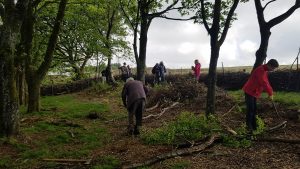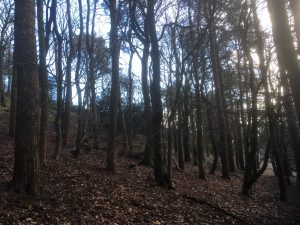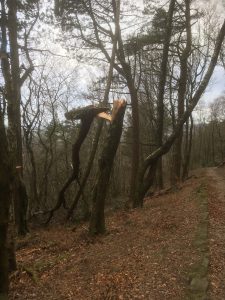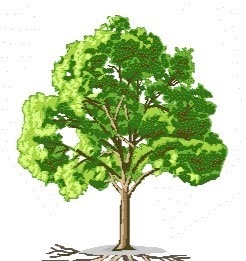Biodiversity Improvement
We love the woodlands within the Gardens and all the creatures which call them home. We want to manage the woodlands for the benefit of wildlife and we are working to increase the number and species diversity.
What does a healthy woodland look like?
Most people, if asked, would draw something like this:
The tree has a wide, well spread canopy to help it to catch lots of light from the sun in its leaves.
It should have a well-developed and extensive root system spreading out in all directions – much wider in fact that the branches above them, which helps stabilise the tree.
It will take up lots of water from the soil, its roots will help aerate the soil, have a symbiotic relationship with a variety of fungi and will provide much needed habitat for insects and burrowing mammals.
Its rich canopy will provide habitat and food for even more insects, small mammals and birds. If it’s a native tree species, for example an Oak tree, then a mature healthy tree could help support an incredible 1,600 other species.
A Healthy Woodland has a number of key visible characteristics:
• Species variety – A mix of native tree species, shrubs, wildflowers, grasses and other vegetation is essential. Too many trees of one species means less variety of fungi, insects and other creatures. Our native wildlife thrives best in complex varied woodland where a variety of food is plentiful throughout the seasons.
• Varying heights of trees and shrubs as well as occasional clearings is essential. Many of our insect and bird species feed and nest at different heights. If the trees are all one height, then the lack of variety means there is less suitable habitat and significantly less food available.
• When there is a mix of woodland, grasslands and small bushy areas wildlife can thrive in huge numbers. Patches of bracken, small trees, giving a mixed habitat, creates a greater concentration of different species.
• Rotting wood and leaf litter is also essential, it provides food for fungi and insects, foraging for burrowing mammals and birds – for example Woodpeckers which dig into the rotting wood to feed on insects. As fungi and insects digest the rotting timber essential nutrients are returned to the soil.
• The presence of non-native trees and shrubs can be a problem because while they can provide cover for wildlife, our native insects will not feed upon them.
This means too many non-native species can greatly reduce the amount of food available.
The Rhododendron which once blanketed the Gardens looked lovely but unfortunately, they were very poor as a habitat. Furthermore, Rhododendron acidifies soil making it inhospitable for some of our native trees, shrubs and wildflowers.
The following picture, taken in the woodland above the Bungalow, demonstrates how a healthy woodland can look:

Please note:
• The widely spaced trees with wide spreading canopies
• Lots of side branches
• A good covering of vegetation on the ground
• Gaps in the canopy to let light get to the ground and the plants growing there
• The mix of tree species
• The variety of heights of the trees, and
• The trees in this woodland should also have well developed sprawling root systems.
Now contrast that image with the one below. This picture shows the woodland next to Lever’s Bridge in the Gardens:

Please note:
• The tall thin trees, growing closely together, the canopy of each tree is small and restricted by the growth of adjacent trees, very little light is penetrating below the canopy.
• The lack of side branches, light does not penetrate the crowded canopy and therefore the trees are competing for light by growing taller. No energy is going into developing a wider canopy.
• The trees are not capturing sufficient light to be healthy, and the energy they are capturing from the sun is being used to grow taller.
• A lack of energy also means the trees’ roots are likely to be less developed. This means food is further limited and the trees will be less stable, particularly in the high winds which occasionally buffet the Terraced Gardens.
• As a result, the ground tends to be bare soil. This leads to increased erosion, particularly on steep slopes in heavy rain, and the trees, weakened over time, frequently fall over.
You can see this clearly in the next picture.

